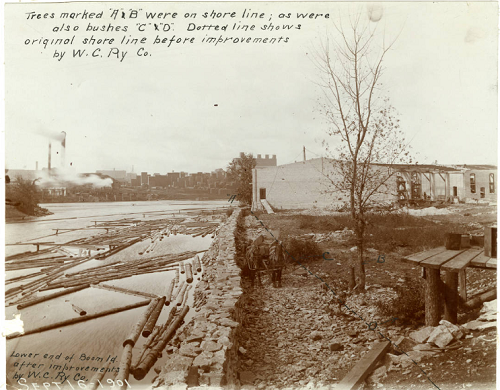Boom Island: One Thing After Another
 Tuesday, February 12, 2019 at 9:14AM |
Tuesday, February 12, 2019 at 9:14AM |  Michael Rainville Jr |
Michael Rainville Jr | Article by Michael Rainville, Jr.
 Minneapolis skyline from Boom Island
Minneapolis skyline from Boom Island
Boom Island, a once bustling industrial island that has transformed into a large, quaint park. It is home to kayaks and canoes, perfect picnic spots, and great views of the Minneapolis riverfront and skyline. A lot has happened throughout the decades upon these 22.5 acres from 5K’s to concerts, and the history of this land is as much a part of humankind history as it is Minneapolis history.
Before humans started developing Boom Island, it was not a very attractive piece of real estate. The back channel of the island was very shallow which meant it was only a true island during high water, and during the rest of the time it was quite swampy. While little to no activity occurred on the island, a very important site lies just across the back channel. During the first decade of the 20th century a team from the Minnesota Historical Society travelled the state to inventory Native American mounds, pottery shards, stone pictographs, and everything in between. One of their discoveries was an ancient burial mound that was found 15 feet beneath the surface near the northwest corner of present-day B.F. Nelson Park. The soil layer that the bones and relics were found in dated the time of burial to the last glacial period, which ended roughly 12,000 years ago. It is somewhat eerie yet amazing to think that humans have found beauty in the back channels of the Minneapolis riverfront for thousands of years.
It was only when pioneers began settling the area that Boom Island saw significant use. During the years leading up to the establishment of the Village of St. Anthony in 1849, a Mdewakanton Dakota woman, who was in Cloud Man’s band on the shores of Lake Bde Maka Ska, ran a ferry service from Boom Island across the river to the area around the mouth of Bassett Creek using her log canoe. Once the first Hennepin Avenue Bridge opened in 1855, there was no need for a ferry service anymore, but Boom Island gradually transformed into Minneapolis’ lumber milling industry. During the industry’s peak, there were too many sawmills to count, so to make things easier the lumberjacks up in northern Minnesota would apply company stamps to the logs they cut down before they tossed them into the Mississippi. Once the logs floated down to Minneapolis, a boom, which is a bunch of logs chained together across the river from bank to bank, caught the logs at Boom Island where the sawmills would then find their company stamped logs and cut them into lumber. It was a log boom, not an explosion or Fourth of July fireworks, that provided the name for the island.
As the forests of Minnesota started to dwindle, the logging industry slowed down significantly. To make matters worse, in 1893, Minneapolis’ largest fire devastated the area, and most of the debris from the fire was bulldozed into the back channel of the island, which permanently connected it to the east bank.
 Boom Island when the railway owned it. Facing east, taken roughly where the current pedestrian bridge is; roundhouse can be seen in the background.
Boom Island when the railway owned it. Facing east, taken roughly where the current pedestrian bridge is; roundhouse can be seen in the background.
The turn of the century slowly saw Boom Island change from a sawmill hub to a rail hub. The Wisconsin Central Railway turned the island into a train yard with roughly 28 tracks and a roundhouse. The trains would enter the island via the current pedestrian bridge that connects Boom Island to Nicollet Island. The railway abandoned the train yard in the early 1970s, and the city quickly acquired the land. A few years later that land came close to being used for Interstate 335, which would connect I-94 to I-35W, but the local neighborhood had different plans and became the first neighborhood board to stop a federal project in the US.
After a decade of other industries occupying Boom Island, it was sold to the Minneapolis Park Board in 1982 for $2.6 million. During the clean up of the area, the Park Board also considered digging out the back channel to make it a true island once again, however, that would have been far too expensive. The park was opened in 1987 and was officially completed in 1988. Since then it has been a place to enjoy a walk along the river, launch a boat, have a party, and fly a kite. Important events have also taken place on Boom Island since it has turned into a park. Numerous concerts have been performed on the island from The Pointer Sisters and the Oak Ridge Boys to Hippo Campus and Chance The Rapper. In 1996, the Olympic torch relay made a pit stop at the park to spend the night before heading out on its way to Atlanta.
 Credit: Michael Rainville. Jr. Taken at the February 10 Klobuchar event.
Credit: Michael Rainville. Jr. Taken at the February 10 Klobuchar event.
Most recently, on a very snowy Sunday along the riverfront, Boom Island became the starting point for Senator Amy Klobuchar’s 2020 presidential campaign. A lot has happened on this 22.5-acre piece of land, and I’m sure there will be more to come.
- - - - - - - - - - - - - - - - - - - - - - - - - - - - - - - - - - - - - - - - - - - - - - - - - - - - - -
 About Michael Rainville, Jr.
About Michael Rainville, Jr.
A 6th generation Minneapolitan, Michael Rainville Jr. received his B.A. in History from the University of St. Thomas, and is currently enrolled in their M.A. in Art History and Certificate in Museum Studies programs.
Michael is also a lead guide at Mobile Entertainment LLC, giving Segway tours of the Minneapolis riverfront for 6+ years.
He can be reached at mrainvillejr@comcast.net.
